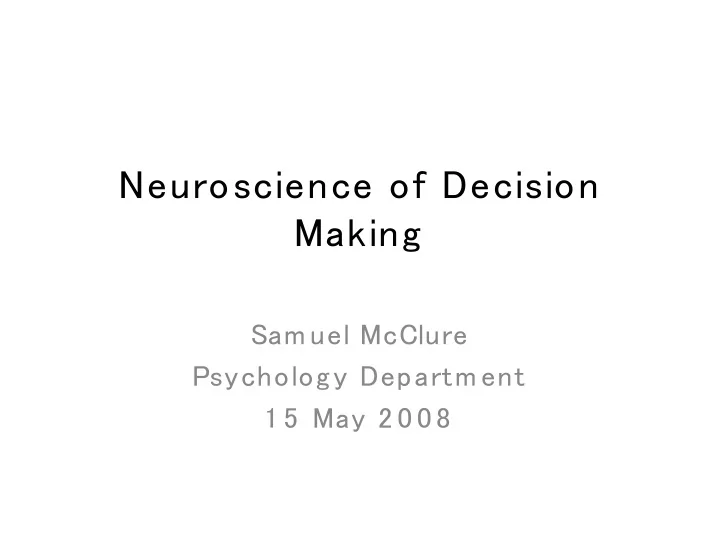

Neuroscience of Decision Making Sam uel McClure Psycholog y Departm ent 1 5 May 2 0 0 8
The Ultim atum Gam e • $ 1 0 to divide between two players • “Proposer” chooses a division • “Receiver” can either – Accept: both receive proposed am ounts – Reject: both receive nothing • How m uch should the Proposer offer?
The Trolley Problem 8 5 %
The Footbridge Problem 1 2 %
Intertem poral choice • Choice involving rewards available at different tim e delays
Example W ould you rather have $ 1 0 today or $ 1 1 tom orrow? W ould you rather have $ 1 0 in a year or $ 1 1 in a year and a day?
Can behavior be captured by form al m odels?
The astonishing hypothesis • “You, your joys and your sorrows, your m em ories and your am bitions, your sense of personal identity and free will, are in fact no m ore than the behavior of a vast assem bly of nerve cells and their associated m olecules” (Crick) • W ith m echanistic / com putational m odels of the brain we m ay be able to derive laws of behavior
Introduction to the brain • Approxim ately 1 0 0 billion neurons • Each with up to 1 0 ,0 0 0 connections with other neurons • Most com plicated com putation device known in the universe • Com m unication via electrical im pulses and propag ated by chem ical synapses
Brain Recording Methods
Brain Stim ulation Reward A neural substrate that replaces external reward
Midbrain dopam ine system
Single-unit Recording
• Encode a reward prediction error • For a stim ulus that predicts reward, dopam ine f i ring indicates value of reward (Schultz et al., 1 9 9 7 )
Role for the prefrontal cortex • Greatly expanded in people com pared to other anim als • Supports higher cognitive processes (working m em ory) • Critical for decision-m aking (e.g. shopping experim ent)
Recording hum an brain activity: Functional Mag netic Resonance Im ag ing • Allows m easurem ent of brain activity at the scale of individual brain structures (m m ) • Tem poral resolution is on the order of m any cognitive processes (sec) • Non-invasive → For the f i rst tim e we can m easure close to the root cause of decision m aking
Hypothesis Dopam ine-related reward system s discount reward at a higher rate than does the prefrontal cortex. 1 .0 DA-related system s discount value prefrontal cortex 0 .0 tim e
Free Response 2 s 12 s ∈ { Today, 2 weeks, 1 month } d ∈ { 2 weeks, 1 month } d'-d ∈ {1%, 3%, 5%, 10%, 15%, 25%, 35%, 50%} (R'-R)/R
Reg ions that respond preferentially to im m ediately available rewards A 10 MPFC VStr MOFC PCC T 13 0 x = 4mm y = 8mm z = -4mm PCC VStr MOFC MPFC B 0.4 % Signal Change 0.2 0.0 -0.2 -4 0 4 8 Time (s) d = Today d = 2 weeks d = 1 month
Reg ions that respond equally to rewards at all delays A B VCtx PMA RPar 1.2 DLPFC RPar % Signal Change 0.8 0.4 LOFC 0.0 x = 44mm -4 0 4 8 Time (s) PMA VCtx DLPFC VLPFC LOFC SMA x = 0mm 10 0 T 13 d = Today d = 2 weeks d = 1 month
Relative activity by choice 0.05 Normalized Signal Change prefrontal 0.0 dopamine -0.05 Choose Choose Early Late
Am ygdala and the Ultim atum Gam e Sanfey et al. (2 0 0 3 ) Unfair Offers 1 0 0 Contrast Value 6 0 Prefrontal Cortex Insular Cortex 4 0 2 0 Accept Reject
fMRI Results Greene et al. (2001) Posterior Medial Frontal Cortex Cingulate/ Precuneus Angular Gyrus Dorsolateral Emotional Areas Prefrontal “Cognitive” Areas Cortex (PFC) Brain Activity Moral Personal Moral Im personal Non-m oral Dilem m as Dilem m as Dilem m as
VMPFC and m orality
People are utilitarian without VMPFC
Transcranial Mag netic Stim ulation (TMS)
Stim ulating DLPFC increases acceptance of unfair offers in the Ultim atum Gam e 1 6 /4 offers
Are people generally rational? • “Autom atic” brain responses create biases and heuristics that are probably g enerally correct • W e also have a prefrontal cortex to enable f l exible behavior and correct decision errors (som etim es)
Recommend
More recommend